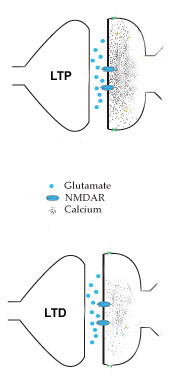|
|


A
Microprocessor That Simulates a Synapse
The precise role or roles that LTD plays in the manufacture of memories have yet to be determined. One thing is certain: it does not seem to be only the “opposite” of LTP. It might play a more active role than causing superfluous memories to be forgotten. Thus, we know that too little LTD diminishes certain types of memory.
|
|
|
Long-term depression (LTD)
was discovered in the cerebellum in the early 1980s. Therefore,
slightly less is known about its workings than about those of the
other major mechanism of synaptic plasticity, long-term
potentiation (LTP), which was discovered about a decade earlier.
Scientists soon discovered, however, that LTD was not limited to
the cerebellum and that it also occurred in the synapses of the cortex,
the hippocampus, the corpus striatum, and other structures.
If LTD is so common, it is probably because it plays an
essential role in memorization. The question is still open,
however, as to whether LTD contributes directly to the storage
of memories, as LTP does, or whether it simply makes us forget
the traces of things we learned long ago so that we can learn
new things. Some models of procedural
memory, for example, postulate that the neural networks
of the cerebellum become more efficient by “depressing” the
synapses that have led to errors in learning motor behaviours.
Contrary to LTP, which is triggered by high-frequency stimulation
of the synapses, LTD is produced by nerve impulses reaching
the synapses at very low frequencies (1 to 5 Hertz). The
synapses then undergo the reverse transformation from LTP:
instead of becoming more efficient, the synaptic connections
are weakened.
The reason for this difference comes
from the differing effects that these two activation patterns
have on the concentration of calcium ions inside the cell:
LTP increases this concentration substantially, but LTD increases
it by only a small amount. These differing concentrations
of calcium in the cell activate different second messengers.
In the case of LTP, the high calcium levels activate kinase
proteins, while the small amount of calcium released by LTD
activates phosphatases instead. It
is these enzymes that modify the synapse to make it more
or less efficient at relaying nerve impulses.
Interestingly, the same neurotransmitters
(glutamate) and the same receptors (NMDA) are involved
in both the large influx of calcium associated with
LTP and the small influx associated with LTD. The
forgetting generated by LTD is therefore just as
active a process as LTP and employs, at least at
the start of the cascade of chemical reactions, the
same molecules. |
|
 |
|
|





